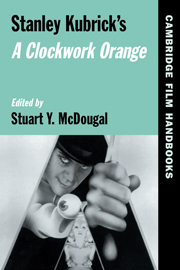Book contents
- Frontmatter
- Contents
- Acknowledgments
- List of Contributors
- Introduction: “What's it going to be then, eh?”: Questioning Kubrick's Clockwork
- 1 A Clockwork Orange … Ticking
- 2 The Cultural Productions of A Clockwork Orange
- 3 An Erotics of Violence: Masculinity and (Homo)Sexuality in Stanley Kubrick's A Clockwork Orange
- 4 Stanley Kubrick and the Art Cinema
- 5 “A Bird of Like Rarest Spun Heavenmetal”: Music in A Clockwork Orange
- REVIEWS OF A CLOCKWORK ORANGE, 1972
- A Glossary of Nadsat
- Filmography
- Select Bibliography
- Index
Introduction: “What's it going to be then, eh?”: Questioning Kubrick's Clockwork
Questioning kubrick's clockwork
Published online by Cambridge University Press: 29 January 2010
- Frontmatter
- Contents
- Acknowledgments
- List of Contributors
- Introduction: “What's it going to be then, eh?”: Questioning Kubrick's Clockwork
- 1 A Clockwork Orange … Ticking
- 2 The Cultural Productions of A Clockwork Orange
- 3 An Erotics of Violence: Masculinity and (Homo)Sexuality in Stanley Kubrick's A Clockwork Orange
- 4 Stanley Kubrick and the Art Cinema
- 5 “A Bird of Like Rarest Spun Heavenmetal”: Music in A Clockwork Orange
- REVIEWS OF A CLOCKWORK ORANGE, 1972
- A Glossary of Nadsat
- Filmography
- Select Bibliography
- Index
Summary
On March 7, 1999, Stanley Kubrick died at his home outside of London after nearly completing the editing of his final film, Eyes Wide Shut. He was seventy years old and had lived a rather reclusive existence in England since 1974. Eyes Wide Shut, starring Tom Cruise and Nicole Kidman, was his first film in over a decade. Following several years of planning, the actual filming had occupied Kubrick and his stars for more than 15 months. Much fanfare accompanied its release in the summer of 1999 (Cruise and Kidman were on the July 5th cover of Time magazine), but the critical response was decidedly mixed, with some critics viewing it as a “haunting, final masterpiece” and others as a disappointment. Although Kubrick had prepared a final cut of the film before his death, the studio redefined the meaning of “final cut” by adding digitalized figures optically to obscure the explicit sexual activity of one of the film's central scenes before releasing the film in America. Kubrick's brilliant career ended with controversy and debate – characteristics that had marked his output at least since the release of Lolita (1962). Why did Kubrick's films – so varied and diverse – engender such heated discussion? Few directors of his stature have produced films that have consistently provoked so much controversy.
Stanley Kubrick began as a staff photographer for Look magazine at the age of seventeen. In part because of an indifferent high school record, Kubrick chose not to attend college.
- Type
- Chapter
- Information
- Stanley Kubrick's A Clockwork Orange , pp. 1 - 18Publisher: Cambridge University PressPrint publication year: 2003
- 2
- Cited by



